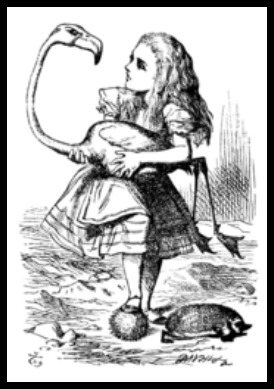Episode 28: Alice in Wonderland
Once a season we step back from the factual historical world into the fictional historical world. This season, while stepping back, we fell into a rabbit hole of sorts and found ourselves becoming curiouser and curiouser about Alice. Alice in Wonderland, that is.
This episode is all about Alice. Who was she, how did these books about her come to be and who is her creator, Charles Lutwidge Dodson (more commonly known as Lewis Carroll)? What is it about this story that has allowed it to endure for 150 years? Is it the charm or is it the mystique that surrounds not only the tale, but the life of the writer?
Originally written for a child, this fantasy deals with some very dark images and has generated some wholly grown-up interpretations.Yet, it has been adored by children and adults alike. Alice’s Adventures in Wonderland and Through the Looking Glass and What Alice Saw There have been in continuous publication since they were first published in the late 1800’s.
We discuss the storylines of these two books in our companion mini-cast, Beckett and Susan’s Adventures in Wonderland and What They Saw There. If you are not familiar with the story, or need a refresher, please give a listen to that podcast first. Some of the details of this episode are better understood within the context of those stories.
On July 4th, 1862 Charles Dodgson, a friend and three young Liddell sisters- Lorina, Edith and 10 year-old Alice- took a rowing trip up a river. As was tradition for this group, Charles began to tell stories. One in particular enchanted young Alice who asked if he could write it down for her. He did, and presented her with a hand written and self-illustrated Alice’s Adventures Under Ground some time later. With further editing, reworking and creating, Charles published the tale (with illustrations by John Tenniel) as Alice’s Adventures in Wonderland three years after that boating trip.
Who was Charles Dodgson? He was the third of eleven children, although the first male in his family. His father, Charles, was a clergyman and mother, Francis Jane, raised the large and close upper- middle class family in Cheshire, England. Young Charles was gifted academically and excelled in school (although he had a stint in a rather notorious institution that may not have been the cheeriest of times). When it came time for Charles to decide on a career path he became a mathematics lecturer at Oxford.( Maybe not the most obvious choice for a man with a stammer). He was quite religious, and an ordained deacon- although he never entered the priesthood as his employer would have required. He was also a writer, penning magazine articles and poems under the name Lewis Carroll, and a very accomplished amateur photographer .
The mystique of Lewis Carroll that endures is probably based on the loss of some key diary entries after his death, and what is known was often left to very loose interpretation. We knock out some of the myths and common misconceptions during the podcast including:
Did he stammer only around adults? (No, he stammered when speaking with children as well, they may have been more understanding, however.)
Was he shy? (No, he was very social and had a wide circle of friends.)
Was he a pedophile? (No, probably not. When the social context of the times, as well as the trends in photography are taken into consideration evidence seems to point to no.)
We cover quite a bit more in the podcast, but the one that pertains the most to this topic? Who WAS Alice and who was she to him?
Alice Liddell was the forth of ten children of Henry and Lorina Liddell (rhymes with ‘riddle’). Henry was the Dean of Oxford during a large chunk of Charles’ time there, and his boss. Charles was a good family friend, spending time with the whole family, not just Alice. He photographed all of the children, and does have several existing portraits of Alice.
Alice lived a very long and full life, marrying a man of means she became a society hostess and mother of three boys. She held on to her original gift from Charles for most of her life, although a series of situations forced her to sell it in her old age.
But she doesn’t LOOK like the Alice you know, does she? As Charles was rewriting his original story, and combined forces with illustrator John Tenniel and sent John images of a couple of other young girls who looked more like the girl in his mind including this one:
The story of Alice lived on long after the deaths of both Charles Dodgson and Alice Liddell. Alice and her friends have crept into our language (“Off with her head!”) and culture (See: Tom Petty Don’t Come Around Here No More or any number of other musical references). We don’t really know when we are going to stumble into her, but when we do- we feel like we are meeting with an old friend.
Time Travel With The History Chicks
Have you fallen into the rabbit hole that is the world that surrounds Alice in Wonderland? Where to next? Oh, why here is a note, it says “READ ME!”
We suggest that you start with Annotated Alice, by Martin Gardner. In this (really big) book you will find the original text and illustrations for the two books, as well as commentary about the subject matter.
Are you interested in learning more about the man behind the tales? We liked The Mystery of Lewis Carroll by Jenny Woolf. Although there are MANY books about this man out there, and many contradict the others…that’s kind of what’s fun about the mystery, don’t you think?
Why should all the recommendations be non-fiction? With this topic, it just doesn’t make sense. Give these two a try: The Looking Glass Wars by Frank Beddor.
If you are as drawn to the work of Mary Blair as Susan was, this is the book version that she gushed discussed.
Alice All The Things! (History Chicks Internet version)
Read both Alice’s Adventures in Wonderland, Through the Looking Glass and The Hunting of the Snark online. LibriVox also has audio versions available.
AlteredAlice– links to Alice inspired art from all over the world.
Lostepedia– Many references within the TV show LOST. Many. (As in:enough to get you to watch it again)
Contrariwise– One of many online groups whose purpose is to discuss and exchange information about Lewis Carroll and his beloved tales.
Carrollmyth: a super slick site that helps address some of the myths surrounding the man.
And, of course, please please, take a cruise through the work of the Lewis Carroll Society (link to North America, but that’s only because we are in North America). If you investigate that site you can easily find links to many of the photographic works of the man, as well as lots of other very fascinating information. You could be there for a while.
And finally ( because, really, where else are you going to find it?) a last look at the Mock Turtle and a recipe for Mock Turtle Soup. You are most welcome.
The Walrus and the Carpenter restaurant, In Seattle- which probably doesn’t serve Mock Turtle Soup, but we thought it was pretty interesting.
















